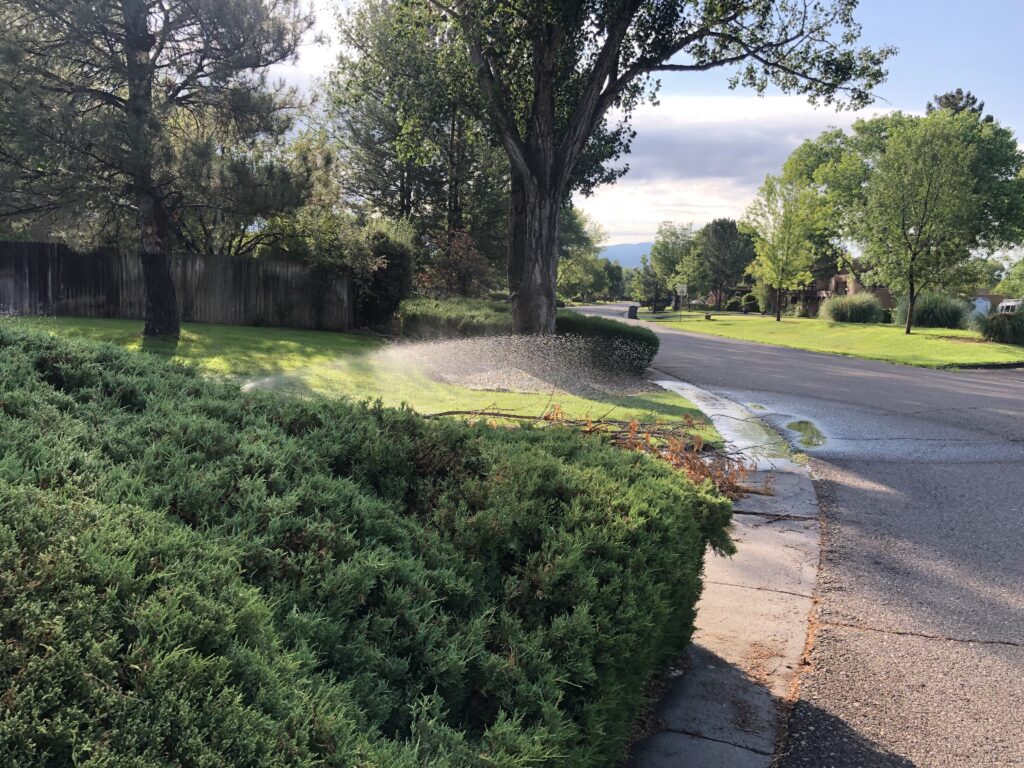
In drought, we pump groundwater. Albuquerque’s Rio Grande Valley, summer 2021
I dropped off the Santa Fe Overland at Albuquerque about a year ago during the drouth that prevailed over the southwest at that time. The range was as dry and hard as a table. Rivers and streams had dried up. Cattle were dying and the country seemed utterly desolate.
Imagine my astonishment and delight when I visited this thirty-acre truck garden to find trees, flowers, grasses and the entire range of vegetables growing in the most luxurious and prolific way. It was like an oasis in the desert. Everywhere stretched the rows of beautiful green, demonstrating the resurrection power of irrigation.
Drouth had no terrors here. This grower laughed at her threats and called her bluff. Even a dried up river did not taunt him, for he simply tapped the underflow near the surface and was pumping at low cost an immense stream of water.
– Albuquerque Journal, Oct. 30, 1905, quoting an unnamed author writing in the monthly magazine “The Earth” describing their visit to Blueher’s Gardens in Albuquerque’s Old Town
I thought a lot about this passage, which my book coauthor Bob Berrens found in an old Albuquerque Journal, on my Sunday bike ride through the Albuquerque reach of the Rio Grande Valley.
While the Rio Grande itself, the part between the levees, is drying, the trend Herman Blueher and the other Old Town market gardeners started in the 1890s – using wells to keep parts of the valley floor green even as the river dries – has become a dominant way of life in the Rio Grande Valley.
Between the levees, the river in 2022 has begun drying in the Albuquerque reach for the first time in four decades, as we grind through the summer of our third consecutive terrible spring runoff. By one measure I’ve been using, this is the worst three-year stretch here since the drought of the 1950s.
It’s a complicated mix right now of hydrology and management decisions. While the river channel itself, the part between the levees, dwindles, flows of water in the irrigation ditches through town are actually up a bit. This almost certainly won’t last. The Middle Rio Grande Conservancy district has burned through the last of its imported San Juan-Chama Project water, and the only water left in storage is a bucket set aside to ensure the valley’s Native American Pueblos, with their senior water rights, can continue irrigating.
But get off the river into the communities that surround it, and you’ll barely notice the drought.
After riding out onto the Alameda bridge yesterday to gape in dark fascination at the dwindling river, my mental health management ally Scot (bike rides, amiright?) and I ducked into what I think is called the Rio Grande Estates subdivision, a little cluster of homes built in the 1980s off of Rio Grande Boulevard in the far North Valley.
Last year around this time, as the river limped, a bike ride through Rio Grande Estates was an “aha” moment for me.
On the ride: lawns, green, sprinklers spraying into the street (see picture above from that fateful day).
Home with the maps: what, what? All those homes have their own shallow wells!
When Johnson Drilling put in wells in the summer of 1988, they found a good, productive aquifer layer of gravels at about 30 feet down. The entrance to the neighborhood here is about a quarter mile from the river – the part where water usually flows on the surface. The interconnections between surface and underground water is such that the gravel layer Johnson hit is basically a part of the river – the “underflow”, as our 1905 correspondent put it.
“Drouth had no terrors here.”
What Bob and I call the “Ribbons of Green” in the new book very intentionally includes this. Our ribbons extend far beyond the boundaries of “river” set by the levees, because this is all part of the river too – the tree-lined ditchbanks, the lush lawns of these valley homes. We’ve pinned the river itself between narrow levees and then manually spread its dwindling water ourselves – with diversion dams and ditches, or with our groundwater wells – across the river’s old flood plain.
If you’re irrigating off of a ditch, this year is about to get a lot tougher. If you’ve got a well – for your lawn, or your pasture, or your farm – you’ll be OK this year. How long that can continue is an open question, very locally situational.
I’m off for the next couple of days to a state legislative committee hearing where folks will be discussing a bunch of relevant questions about what we do next:
- How do we ensure that our indigenous communities’ rights to water are respected as supplies shrink under climate change?
- What are the long run implications of our increasing use of groundwater to fend off “drouth”?
- What of the environmental flows in the river itself, the part between the levees?
- How can we protect the communities of the Middle Rio Grande Valley’s water supplies while also meeting our legal obligations to deliver water downstream?
If these questions had easy answers, we’d have already finished the quiz and handed it in to the proctor. This is hard stuff.
